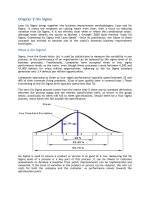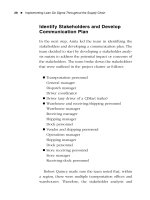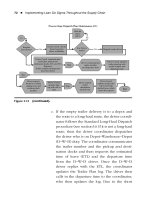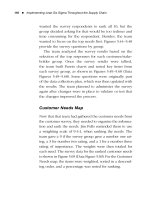Graeme Knowles Six Sigma pot
Bạn đang xem bản rút gọn của tài liệu. Xem và tải ngay bản đầy đủ của tài liệu tại đây (5.43 MB, 179 trang )
Download free ebooks at bookboon.com
2
Graeme Knowles
Six Sigma
Download free ebooks at bookboon.com
3
Six Sigma
© 2011 Graeme Knowles & Ventus Publishing ApS
ISBN 978-87-7681-852-4
Download free ebooks at bookboon.com
Please click the advert
Six Sigma
4
Contents
Contents
1 Introduction 10
2 Background and History 11
2.1 Development of Quality inking 11
2.2 Six Sigma: e Next Evolution 12
2.3 Denition of Six Sigma 13
2.4 Summary 13
3 Why Six Sigma? 14
3.1 Introduction 14
3.2 To Improve Financial Performance and Protability 14
3.3 To be Responsive to, and Focused on, Customers 17
3.4 To Improve Product and Service Performance 19
3.5 Contributing to Organizational Learning 22
3.6 Summary 23
4 Six Sigma: Key Strategic Concepts 25
4.1 Six Sigma is Strategic 25
4.2 Six Sigma is About Customers 26
4.3 Six Sigma is About Variation 26
360°
thinking
.
© Deloitte & Touche LLP and affiliated entities.
Discover the truth at www.deloitte.ca/careers
Download free ebooks at bookboon.com
Please click the advert
Six Sigma
5
Contents
4.4 Six Sigma is About Process and Scientic Investigation 28
4.5 Six Sigma is About People and Learning Not Cost 28
4.6 Summary 29
5 Strategic Six Sigma 30
5.1 Introduction 30
5.2 Vision, Mission and Values 31
5.3 Strategic Objectives 33
5.3 Hoshin Kanri and Six Sigma 35
5.4 Summary 38
6 Customers 40
6.1 Introduction 40
6.2 Customer Satisfaction and Customer Value 40
6.3 Summary 43
7 Variation 45
7.1 Introduction 45
7.1 Special and Common Cause Variation 46
7.2 Process Capability 47
7.3 Summary 49
Increase your impact with MSM Executive Education
For more information, visit www.msm.nl or contact us at +31 43 38 70 808
or via
the globally networked management school
For more information, visit www.msm.nl or contact us at +31 43 38 70 808 or via
For almost 60 years Maastricht School of Management has been enhancing the management capacity
of professionals and organizations around the world through state-of-the-art management education.
Our broad range of Open Enrollment Executive Programs offers you a unique interactive, stimulating and
multicultural learning experience.
Be prepared for tomorrow’s management challenges and apply today.
Download free ebooks at bookboon.com
Please click the advert
Six Sigma
6
Contents
8 Processes and Scientic Investigation 50
8.1 Introduction 50
8.2 Business Processes: e Reality 52
8.3 Scientic Investigation 53
8.4 Summary 54
9 People and Organizational Learning 55
9.1 Key Six Sigma Roles 55
9.2 Belt System Issues 57
9.3 People and Change 57
9.4 Organizational Learning 61
9.5 Summary 62
10 Sustainable Six Sigma Deployment 63
10.1 Deployment Model: Kotter 63
10.2 Deployment Logic: System of Profound Knowledge (SoPK) 64
10.3 Steps 1 to 3: Envisioning the Transformation 65
10.4 Steps 4 to 7: Enacting the Transformation 67
10.4 Step 8: Institutionalise the New System 70
10.5 Summary 70
11 Six Sigma Projects: Key Concepts 71
11.1 Basic Statistical Concepts 71
Get “Bookboon’s Free Media Advice”
See the light!
The sooner you realize we are right,
the sooner your life will get better!
A bit over the top? Yes we know!
We are just that sure that we can make your
media activities more effective.
Download free ebooks at bookboon.com
Please click the advert
Six Sigma
7
Contents
11.2 Variation, the Normal Distribution, DPMO and Sigma Levels 73
11.3 e Scientic Method and the DMAIC Cycle 76
11.4 e Four Focuses of a Six Sigma Project 77
11.5 Process 78
11.5 People and Change 79
11.5 Summary 79
12 DMAIC 80
12.1 Introduction 80
12.2 e Dene Stage 80
12.3 e Measure Stage 82
12.4 e Analyse Stage 84
12.5 e Improve Stage 85
12.6 e Control Stage 86
12.7 Summary 86
13 Customer Focus in DMAIC 87
13.1 Introduction 87
13.2 What Does the Customer Value? 87
13.3 What is the Value Stream? 90
13.4 What Design/Process Elements Aect Customer requirements? 91
GOT-THE-ENERGY-TO-LEAD.COM
We believe that energy suppliers should be renewable, too. We are therefore looking for enthusiastic
new colleagues with plenty of ideas who want to join RWE in changing the world. Visit us online to find
out what we are offering and how we are working together to ensure the energy of the future.
Download free ebooks at bookboon.com
Please click the advert
Six Sigma
8
Contents
13.5 Quality Function Deployment 91
13.6 Summary 98
14 Variability Reduction in DMAIC 99
14.1 Introduction 99
14.2 Building and Using Control Charts 100
14.3 Responding to Out of Control Conditions 110
14.4 Process Capability 115
14.5 Responding to Incapable Processes 118
14.6 Evaluating the Measurement System 119
14.7 Summary 123
15 So Aspects of DMAIC 125
15.1 Learning in and Between Projects 125
15.2 People in Improvement 126
15.3 Summary 128
16 Processes in DMAIC Projects 129
16.1 Introduction 129
16.2 Supplier-Input-Process-Output-Customer (SIPOC) Diagram 129
16.3 Process Flow Chart 129
16.4 Value Stream Mapping 130
Contact us to hear more
Who is your target group?
And how can we reach them?
At Bookboon, you can segment the exact right
audience for your advertising campaign.
Our eBooks offer in-book advertising spot to reach
the right candidate.
Download free ebooks at bookboon.com
Six Sigma
9
Contents
16.5 So Systems Methodology 131
16.6 Summary 131
17 DMAIC in Service Organizations 132
17.1 Introduction 132
17.2 Service is Dierent 132
17.3 e Dimensions of Service Quality 133
17.3 Contribution of Six Sigma 134
17.4 Potential Modications to Six Sigma in Service Environments 134
17.5 Summary 135
18 Successful DMAIC Projects 136
19 Example of a Six Sigma Project 137
19.1 Introduction 137
19.2 Project Background 137
19.3 Selection of a Quality Characteristic 137
19.4 Methodology 139
19.5 Summary 150
20 Quality by Design (for Six Sigma) 152
20.1 Introduction 152
20.2 e DFSS Process 154
20.3 e Voice of e Customer 155
20.4 Impact of Late Design Changes 160
20.5 Design for ‘X’ 161
20.6 DFSS Tools 162
20.7 Summary 162
21 Six Sigma: A Critique 163
21.1 Introduction 163
21.2 Accepted Strengths of Six Sigma 163
21.3 Reasons for Failure and Critical Success Factors 163
21.2 Inherent Conceptual Issues 167
21.3 e Future 170
21.4 Summary 171
22 References 173
Download free ebooks at bookboon.com
Six Sigma
10
Introduction
1 Introduction
Six Sigma is one of the most important and popular developments in the quality eld. It has saved huge amounts of
money and improved the customer experience for a large number of organizations across the world, yet it is applied in
an inconsistent and oen reductive fashion in many companies. is has led to criticism in the literature and a number of
abandoned implementations. is study guide is designed to provide an overview of the key elements, important historical
context and current debates in the eld of Six Sigma. It aims to give a coherent view of the underlying principles, and
how these relate to practical application in a range of organizations as well as to other areas of study. e broad Quality
Management context, within which Six Sigma ts, will not be explored in this book in detail. More information on this
can be found in the companion guide: “Quality Management in the 21
st
Century” also available at Bookboon.com.
e guide ows from principles and background to more detailed consideration of Six Sigma as both a business level
initiative and project-based improvement methodology. Due to the complexity of many of the issues addressed, it is possible
to write much more on any single topic but I have tried to cover most of the key points in order to provide a foundation
and further literature linked from the text allows the reader to investigate any topic in more depth if they wish. Finally,
at the end of each chapter there are a number of questions for you to develop your thinking in the area.
Download free ebooks at bookboon.com
Six Sigma
11
Background and History
2 Background and History
Although many proponents of Six Sigma stress the uniqueness of the approach, it is, in fact, part of a continuing evolution
of thinking in what might broadly be called “Quality”. It is important to see Six Sigma within this wider context.
2.1 Development of Quality Thinking
Figure 2.1 indicates the new ideas which arrived in quality at various point in history. e advent of a new era does not
necessarily mean that the practices and principles espoused by earlier eras died out; in fact many examples of crasmanship
or quality assurance can be found today. Nor is the beginning of each era meant to represent the rst articulation of
theories or approaches, but where they became mainstream. e bands indicate, broadly, times when those ideas were
pre-eminent in the quality domain. is history is expanded upon in “Quality Management in the 21
st
Century” also
available at Bookboon.com.
Figure 2.1. A Quality Timeline
2.1.1 Key Building Blocks
Standardization was really the rst important building block, developing the idea that consistency was important, in both
products and processes. is developed into a wider understanding of variation and its impact. e cost of quality movement
alerted managers to the direct linkage of improved quality to the bottom line, while the TQM movement brought focus onto
Quality as a strategic priority and introduced team-working, leadership and involvement of the workforce as key issues.
Download free ebooks at bookboon.com
Six Sigma
12
Background and History
2.2 Six Sigma: The Next Evolution
ere are those who will tell you that Six Sigma is radical and new. e fact is that Six Sigma (done properly) is a recognisable
evolution of TQM. De Mast (2006) sees it as an on-going phase in the evolution of methods and approaches for quality and
eciency improvement. Six Sigma can be seen as the accumulation of principles and practices developed in management
statistics and quality engineering, all of which matured signicantly over the course of the Twentieth Century.
e Six Sigma approach was rst developed in the late 1980s within a mass manufacturing environment in Motorola (Harry,
1998) as they struggled to meet demanding quality targets on complex manufactured products; and become widely known
when GE adopted it in the mid-90s (Folaron and Morgan, 2003; awani, 2004) when, arguably, it evolved from being
a process improvement methodology to a broader, companywide philosophy. Both companies still consider Six Sigma
as the basis for their on-going strategic improvement approach. Since the 1980s Six Sigma has become one of the most
popular improvement initiatives; widely implemented around the world in a wide range of sectors (by companies such
as Boeing, DuPont, Toshiba, Seagate, Allied Signal, Kodak, Honeywell, Texas Instruments, Sony, Bombardier, Lockheed
Martin) that all declared considerable nancial savings (Harry, 1998; Antony and Banuelas, 2001; Kwak and Anbari, 2006).
Other benets claimed for Six Sigma include increased stock price, improved processes and products quality, shorter cycle
times, improved design and increased customer satisfaction (Lee, 2002; McAdam et al, 2005).
Six Sigma has undergone a considerable evolution since the early manifestations (Folaron and Morgan, 2003; Abramowich,
2005). Initially it was a quality measurement approach based on statistical principles. en it transformed to a disciplined
processes improvement technique (based on reducing variation within the system with the help of a number of statistical
tools). For example, Snee (1999) dened Six Sigma as an ‘approach that seeks to nd and eliminate causes of mistakes
or defects in business processes by focusing on outputs that are critical importance to customers’. e denition given
in 1999 by Harry and Schroeder (1999) also denes Six Sigma as ‘a disciplined method of using extremely rigorous data
gathering and statistical analysis to pinpoint sources of errors and ways of eliminating them’.
In its current incarnation it is commonly presented as ‘a breakthrough strategy’ and even holistic quality philosophy
(Pande, 2002; Eckes, 2001). It is now generally accepted that Six Sigma is applicable to various environments such as
service, transactions or soware industry regardless the size of the business (Pande, 2002; Lee, 2002) and being adapted
Six Sigma may lead to nearly perfect products and services. Moreover, Six Sigma is widening its areas of application very
rapidly and there are examples of applying Six Sigma to predicting the probability of a company bankruptcy (Neagu and
Hoerl, 2005) or nding opportunities for growth (Abramowich, 2005).
In the past ve years, hundreds of organizations have indicated their interest in making Six Sigma their management
philosophy of choice. While many of the businesses attempting to implement Six Sigma are well intentioned and want
to implement Six Sigma properly just as General Electric did, there are also those impatient executives who now look on
Six Sigma in the same way as they look on downsizing. is quick-x approach to Six Sigma is a sure path to the same
short-term results that prevent long-term protability.
It is worth noting that the evolution of Six Sigma is continuing with, for example, the integration of Lean Principles,
development of a product/service variant (Design for Six Sigma) amongst others (De Mast, 2006).
Download free ebooks at bookboon.com
Six Sigma
13
Background and History
2.3 Denition of Six Sigma
Before we study the subject of Six Sigma in any depth, we need to dene the term. Perhaps unusually, Six Sigma has 3
distinct elements to its denition:
• A Measure
• A Target
• A Philosophy
Accordingly, it is dened in a variety of ways by several authors, but for the purposes of these notes the denition from
Pande et al (2000) focused on the more comprehensive philosophy of Six Sigma will be used:
“A comprehensive and exible system for achieving, sustaining and maximising business success. Six Sigma is uniquely driven
by close understanding of customer needs, disciplined use of facts, data, and statistical analysis, and diligent attention to
managing, improving, and reinventing business processes.”
A strong structure and clear alignment to organisational goals (particularly nancial) are a key part of the Six Sigma
approach as dened by Eckes (2001). Leadership is provided by a team of Champions – Senior Champion, Deployment
Champion, Project Champion at corporate, unit and department levels respectively supported by a team of experts. e
experts are referred to as Black Belts (who work full time on projects at process level to solve critical problems and achieve
bottom-line results) and Master Black Belts (who provide mentoring, training and expert support to the Black Belts). Ingle
and Roe (2001) note that that this signicant organisational structure can range from 4000 Black Belts in a corporate
population of 340,000 in GE to 120 Black Belts in a corporate population of 100,000 in Motorola. Black Belt training is
typically 16 –20 weeks in GE and a year in Motorola (Ingle and Roe, 2001), although both are interspersed with projects
that bring value to the organisation.
2.4 Summary
is section gives a brief introduction to the history of Six Sigma and recognises it as an evolution in the on-going
development of thinking in the area broadly described as “Quality” (involving as it does developments in quality
engineering, statistics and management theory and practice). A denition reecting the current state of Six Sigma
development is suggested and it is recognised that the current status quo is unlikely to be permanent.
Download free ebooks at bookboon.com
Six Sigma
14
Why Six Sigma?
3 Why Six Sigma?
3.1 Introduction
ere can be few initiatives which have been trumpeted as loudly as Six Sigma; few where the claims have been so
extravagant; and few which divide the quality community so completely. While this section does not, indeed cannot, propose
to investigate fully the evidence supporting the self-declared results of major corporations it does attempt to clarify the level
of expectation placed upon Six Sigma programmes. e sub-sections below address the potential answers to the question;
‘Why Six Sigma?’, and draws on the work of Henderson and Evans (2000) who investigated the GE experience in some detail.
3.2 To Improve Financial Performance and Protability
Bob Galvin (then Motorola president) was reputed to be the man who began the Six Sigma revolution by issuing a ‘Six
Sigma Challenge’ in 1987 for a ten-fold improvement in performance in every 2 year period (Goetsch and Davis, 2010).
Over the 10 years following the call, Motorola claims to have saved $414 billion, increased sales by a factor of 5 and
increased prots by 20% each year (Pande et al, 2000). GE declared that for 3 years (1996-1998) Six Sigma related savings
were about $2bn; Honeywell stated that its annual Six Sigma savings as around $600-700 million; and Dow Chemicals
claimed $2.2bn of Six Sigma nancial benets (Lee, 2002).
It is oen stated that a ‘typical’ company operates around the 3 sigma level (Murphy, 1998) and there have been a number of
attempts to quantify the nancial eects of varying sigma levels. Klefsjo et al (2001) suggest that for Six Sigma performance
levels the cost of poor quality would be less than 1percent of sales, while for 5 Sigma that would rise to 5-15 per cent, at
4 Sigma the cost would be 15-15 per cent and at 3 Sigma levels it would equate to around 25-40 per cent of sales.
ere are countless other (admittedly self-reported and largely unveried) claims for the nancial benets of Six Sigma;
with the savings achieved due to decrease in operational costs, reduction in scrap and rework rates, etc. (Lee, 2002). e
two important ideas which support the logic of this are ‘Cost of Poor Quality’ and ‘Waste’, both of these are explored
briey below and in more detail in “Quality management in the 21
st
Century” also available on Bookboon.com.
3.2.1 Cost of Poor Quality
Perhaps the most obvious tangible benet of quality improvement is the reduction of costs associated with non-quality. If
we have to throw a product away because we have made an error in its manufacture, it is clear that there is an immediate
nancial impact as all the costs sunk into the product are lost. Similarly, doing an incorrect operation over again absorbs
cost (operator time, power, additional materials, etc.).
Although anyone who works in an organization will be familiar with many examples of both of these issues, business
accounting systems are not set up to capture these costs. Traditional accounting approaches are designed to track the inow
and outow of money in an organization (and, by extension, to product lines or departments). ere is little emphasis on
whether the money in the department is spent eectively. For example, budget reporting will recognise that overtime cost
£100,000 this month, but will not dierentiate between time used to respond to short lead-time customer demand and
time spent correcting errors. Even when it does highlight a cost of poor quality, perhaps in an over-budget condition in
material spend, it will give no clear indication of where exactly the over-spend occurred. Table 3.1 shows Fiegenbaum’s
Prevention-Appraisal-Failure (P-A-F) model of costs of poor quality, although there are others.
Download free ebooks at bookboon.com
Please click the advert
Six Sigma
15
Why Six Sigma?
Cost Area
Cost of Control
(Cost of Conformance)
Cost of Failure of Control
(Cost of Non-Conformance)
Sub-Category Prevention Costs Appraisal Costs Internal Failure Costs External Failure Costs
Description Arise from eorts
to keep defects from
occurring at all
Arise from detecting
defects via test, audit,
inspection
Arise from defects caught
internally and dealt with by
discarding or repairing the
aected items
Arise from defects that
actually reach the nal
customer.
Examples Quality planning
Statistical Process
Control
Quality training
and workforce
development
Product design
verication
Market research
Test and inspection of
purchased materials
Inspection
Testing
Quality audit
Scrap
Rework costs
Management of rework
systems
Rejection paperwork
Warranty costs
Out of warranty
complaints
Product recall
Product liability claims
Loss of customer
goodwill
Table 3.1. Cost of Quality types and examples (adapted from Feigenbaum, 1961)
THE BEST MASTER
IN THE NETHERLANDS
Download free ebooks at bookboon.com
Six Sigma
16
Why Six Sigma?
e lack of clarity of the cost of poor quality in organizations led to a lack of focus on improvement for many years.
It was only with the advent of the “Cost of Quality” approach in the 1950’s (Defoe and Juran, 2010) that organizations
had a nancial tool to assess the costs associated with quality failures and thus focus on the most important areas for
improvement. Six Sigma directly assesses costs of poor quality on a project by project basis, providing clear motivation
for improvement and an indication of expected gains.
e basic logic is that a relatively small increase in spending on prevention activities will deliver a more than compensating
reduction in appraisal and failure costs (see gure 3.1)
Figure 3.1. Quality costs during improvement (adapted from Businessballs.com, 2011)
3.2.2 Waste
Cost of Quality models are certainly helpful in generating momentum in the quality improvement movement, however,
they are, at best, a partial view of the economic benets. e focus on failure neglects aspects of waste which relate to
ow and eciency as opposed to accuracy. For example, an operator having to wait for products from a previous process
would not register on the P-A-F model, but would clearly have an impact on the costs of the organization.
e concept of waste is fairly generic in nature and has been around for a long time. Many organisations refer to ‘non-
value added activities’ and ‘process waste’. However, these are rather broad terms and, whilst it is easy to agree that waste
is bad and should be eradicated (or at least reduced) it does not much help in the process of improvement. e Seven
Wastes were identied by Ohno as part of the Toyota Production System (Ohno, 1988) and have since been widely applied
to process improvement, becoming particularly associated with the principles of lean manufacturing.
It can readily be seen that some of the costs associated with these activities would t neatly into the Cost Of quality
models discussed in the previous section, but that some would be transparent to that system. Table 3.2 indicates the kind
of nancial impacts that might be caused by the types of waste. ose which would not be picked up by a Cost of Quality
measurement system are in bold italics.
Download free ebooks at bookboon.com
Six Sigma
17
Why Six Sigma?
Type of Waste Potential Associated Costs
Waiting Labour cost associated with idle time.
Value of lost production (if units are lost) or cost of overtime if this has to be worked to
catch up.
Cost of late delivery if overall process time aected.
Correction Rework cost (direct and overhead if applicable).
Cost of delays (as above).
Inspection costs.
Disposal costs if correction is not possible.
Paperwork system costs.
Over-Production Storage costs (inc. handling costs & capital tied up).
Extra material costs if excess cannot be sold.
Deterioration/depreciation costs (if appropriate).
Cost of delays (as above).
Processing Additional processing costs (direct and overhead if applicable).
Transportation costs.
Conveyance Additional cost of unnecessary conveyance system.
Cost of late delivery if overall process time aected.
Deterioration/damage costs.
Inventory Storage costs (inc. handling costs & capital tied up).
Deterioration/depreciation costs (if appropriate).
Obsolescence costs (if appropriate).
Motion Additional labour costs (including absenteeism).
Table 3.2. Types of waste and associated costs
is type of approach allows for a clear identication of potential cost savings, whilst also allowing for the improvement
and ‘what to do dierently’ elements of the waste based approach.
e impressive nancial gains associated with Six Sigma certainly account for much of its popularity, but on the downside
may also be responsible for the ‘quick x’ mentality which has characterised at least some of the applications.
3.3 To be Responsive to, and Focused on, Customers
3.3.1 Product Out vs. Market In
We oen consider ourselves ‘expert’ in our customers’ requirements. We, aer all, have been in this business for a long
time; we have much more experience than the typical customer, who may have only bought a few of our products. We
are technically much more au fait with the product, and with those of our competitors.
It is easy to see how this logic leads us to take a rather patronising attitude to customers who either don’t really know what
they want, or don’t understand the complexities of the product. Anyone who has been on the end of a customer service
discussion where they have been told that they must have been misusing the product, or that it was not designed for the
circumstances described, will recognise this mentality.
Download free ebooks at bookboon.com
Please click the advert
Six Sigma
18
Why Six Sigma?
Figure 3.2. Product Out Concept
is is known as the ‘Product Out’ concept (Shiba, Graham and Walden, 1993) where the focus is on working to specication
or instruction and the product is ‘pushed’ from the company to the customer. e problem with a product out focus is
that it is slow to respond to changing markets and customer requirements (an ever more signicant aspect of the world
today). e ‘Market-In’ approach (Shiba, Graham and Walden, 1993) allows for a much more responsive system and places
a requirement on the organization to go and nd out the customer requirements.
Customers may not be expert in the technicalities of the product, but they do know what the need the product to do for
them.
With us you can
shape the future.
Every single day.
For more information go to:
www.eon-career.com
Your energy shapes the future.
Download free ebooks at bookboon.com
Six Sigma
19
Why Six Sigma?
Figure 3.3. Market In Concept
e Six Sigma initiative attempts to deploy the voice of the customer through the processes of the organization. Improvement
projects should be as much about customer value as they are about nancial benet (Schroeder et al, 2008). Henderson
and Evans (2000) note evidence that in GE Aircra Engines division the Six Sigma programme directed the business to
look at the needs of the customer and focus on their priorities. Schroeder et al (2008) notes that some service organizations
prefer to track customer satisfaction, rather that savings.
3.4 To Improve Product and Service Performance
Clearly, a reduction in defects will be helpful to our customers in that it will reduce the likelihood that and defects will
escape detection and aect the nal customer. However, in looking to reduce variation in product and service outcomes
Six Sigma takes a step beyond the out-moded goalpost approach to quality and recognises the deeper truth of the Taguchi
Loss Function (Taguchi, 1986).
3.4.1 Taguchi Loss Function and Customer Satisfaction
e Taguchi Loss Function (Taguchi, 1986) shows how increasing capability (i.e. reducing product variation in relation to
the tolerance band) can improve customer satisfaction even if all products already meet specication. e Loss Function as
dened by Taguchi is basically a challenge to the traditional ideas on what constitutes acceptable quality for manufactured
products. Figure 3.4 contrasts Taguchi’s Loss Function and the traditional tolerance (also known as specication)-based
approach to product quality.
Download free ebooks at bookboon.com
Six Sigma
20
Why Six Sigma?
A
B
C
D
GoodBad Bad
‘Goalpost ’ Approach Taguchi Loss Function
Figure 3.4. Loss function vs. tolerancing.
Traditional thinking is that any product that falls inside the tolerance limits is “good”. e unspoken assumption here is
that they are equally good and that no cost is incurred. Following the logic through we can see that any product falling
outside the limits is bad and a cost equivalent to the full cost of producing that product is incurred (oen referred to as
the scrap cost). In this simple scenario we have assumed that reworking the product is either not possible or uneconomic.
Again, the hidden implication is that all products outside the limits are equally bad.
e usual derivation of tolerances further throws this attitude into doubt. ey are usually based upon what was done last
time or the draughtsman’s ‘best guess’. ere also exists an element of barter in the generally adversarial relationship between
design and production with designers wanting to tie production down to extremely tight tolerances and manufacturing
wanting to be able to drive a bus through them. Seen in this light tolerances can be viewed as, at best, somewhat arbitrary.
In any case, the specication limits will always be what is acceptable, rather than what the customer or designer wants. In
most cases the ideal will be all products exactly on target; this will mean the design works exactly as intended. However,
this is recognised as unrealistic, hence the use of specications.
Taguchi states that to regard the transition from good to bad as a step change is not logical. He contends that, provided the
nominal has been specied correctly, any deviation from this target value will have a detrimental eect on the performance
of the product and will therefore cause an overall “loss to society”. is concept is probably one of the more esoteric of
Taguchi’s ideas. A good example may be to consider the thickness of a polythene sheet used by farmers to protect crops;
if the sheet thickness is low (but within tolerance) it may tear more easily and allow the weather to damage the crops. e
costs generated by this failure will be outside the company but very real. Firstly, farmers will incur additional replacement
costs; secondly, the reduced crop yield will increase the price in the marketplace, a loss borne by all society.
In many cases it is easier to think of the “loss to society” in terms of a long-term loss to the company. e reduced
performance of the product caused by non-optimal parts will cause relative dissatisfaction in customers who will, given
sucient stimulus, take their trade elsewhere. e further from optimum performance we deviate the quicker will be
their defection.
Download free ebooks at bookboon.com
Please click the advert
Six Sigma
21
Why Six Sigma?
C
C
B
B
US plant
Figure 3.5. Sony TV production.
Figure 3.5 is an illustration of the loss function as a long-term loss to the company, and appeared in a Japanese newspaper
called “e Asahi” in 1979. e article discussed the preference of American consumers for television sets built by Sony in
Japan over those built at an identical plant in the USA. e key performance characteristic is colour density. e ‘A’ band
represents excellent colour density; the ‘B’ band good colour density and the ‘C’ band acceptable colour density. Outside
of the limits of the ‘C’ bands colour density is deemed unacceptable and the TV is considered a reject.
Clearly from the gure, Sony Japan was producing defects whilst the American plant was not. However, the key fact is
that the chances of having an ‘A’ or ‘B’ grade TV from the Japanese plant was much greater than the American one where
the odds of getting any grade were roughly similar. e “in tolerance is OK” attitude was costing a lot of sales for the
American plant. e Taguchi belief that variation from the nominal is expensive seems much closer to the truth in this case.
Contact us to hear more
Do your employees receive
the right training?
Bookboon offers an eLibrairy with a wide range of
Soft Skill training & Microsoft Office books to keep
your staff up to date at all times.
Download free ebooks at bookboon.com
Six Sigma
22
Why Six Sigma?
Taguchi (1986) states that the loss function takes the quadratic form shown above for all “nominal the best” type
characteristics and the appropriate half of that shape for “bigger the better” and “smaller the better” features. Whether
this is in fact strictly the case is debatable. However the principle that deviation from the target is expensive regardless of
tolerances and that the rate of deterioration of the situation increases with distance from the target is sensible. In fact, as
Wheeler (1995) notes, this eectively creates a new denition of world class quality, one with capability at its heart. No
longer is in specication sucient, the new denition is:
“On target with minimum variation”
3.5 Contributing to Organizational Learning
Six Sigma is inherently a learning process (Wiklund and Wiklund, 2002) and, as such, has the potential to contribute to
organizational learning. is can be seen in the organizational learning cycle (Dixon, 1994) shown below:
Figure 3.6. The Organizational Learning Cycle (Dixon, 1994)
• Experiences need to be spread throughout the organization in order to generate learning.
• Reection, requires the integration of the experience into an organizational context.
• To create shared concepts and mental models collective interpretation of the contextualised experience takes
place.
• Action is required to test the analysis, which underpins the interpretation.
It is clear that a Six Sigma improvement project generates learning through investigation of a process, integrates that
with organizational goals and specic knowledge of statistics, etc. and interprets this to generate improvements through
action. At an organizational level sharing of good practice of projects lis the learning to a higher level. De Mast (2006)
describes the ability to facilitate people at all levels in an organization to learn how processes work and to put this new
knowledge to eective use as the core capability that Six Sigma can bring to an organization. As a meta-capability (one
which spans all domains) this oers much more potential for long-term competitive advantage than the specic project-
based improvements in operational eciency.
Download free ebooks at bookboon.com
Six Sigma
23
Why Six Sigma?
e impact of learning on an organization is to increase organizational capability by equipping it with a better understanding
of processes and outcomes and to allow for the generation of new knowledge and innovation which improves the capability
of the organization to respond to change and new challenges. is is, in fact, a higher order eect than simply improving
processes and generates benets including (Pedler et al, 1997; McHugh et al, 1998):
• Maintaining levels of innovation and remaining competitive
• Being better placed to respond to external pressures
• Having the knowledge to better link resources to customer needs
• Improving quality of outputs at all levels
• Improving corporate image by becoming more people oriented
• Increasing the pace of change within the organization
In fact, organizational learning has been discussed as vital to the survival of organizations in an increasingly volatile world.
“In times of change the learners will inherit the earth, while the knowers will nd themselves
beautifully equipped to deal with a world that no longer exists”
Eric Hoer
Even though it is a higher order endeavour this is, sadly, the least frequently cited reason for exploring Six Sigma.
3.6 Summary
Six Sigma has the potential to contribute to an organization in a range of ways; the common approach of focusing on
nancial measures alone misses some of the more important but less easily measurable aspects.
Figure 3.7. Impact on competitiveness versus diculty for various Six Sigma approaches
Download free ebooks at bookboon.com
Please click the advert
Six Sigma
24
Why Six Sigma?
www.job.oticon.dk
Download free ebooks at bookboon.com
Six Sigma
25
Six Sigma: Key Strategic Concepts
4 Six Sigma: Key Strategic Concepts
ere are a number of important concepts which have come together in the modern Six Sigma philosophy. ese are
summarised in this chapter in order to provide a sound basis for the discussions in later chapters.
4.1 Six Sigma is Strategic
Historically, initiatives centred on quality have frequently been undertaken at a tactical level, focused on projects or cost
reduction. Eckes (2001), amongst others makes the point that Six Sigma activities must be supported by processes and
structures to ensure they move business objectives forward. Knowles et al (2005) suggest that the DMAIC cycle should be
replaced by two linked cycles, one setting strategic objectives, from which project denitions are developed and followed
through with the outcomes feeding back into the strategic cycle to understand the contribution made to strategic objectives
and what that means at a strategic level.
Define Objectives
Measure & Control
Define ProjectControl
Model & Measure
Analyse
Improve
Strategic Cycle
Operational Improvement
Cycle
Figure 4.1. The Supply Chain Conceptual Improvement Model (Adapted from Knowles et al, 2005)
Although senior management may profess their interest and support the practical evidence suggests that most quality
related activities were delegated downwards to quality managers and that, despite the evidence of benet, they were
never seen as central. Six Sigma has moved the focus back to quality as a strategic initiative, perhaps most famously in
the person of Jack Welch who not only declared that Six Sigma was central to the way he expected GE to do business and
based 40% of senior management bonuses on achievement of Six Sigma targets but also required that (as he did) senior
management (Henderson and Evans, 2000):
• Personally spend time in each Six Sigma training wave talking to candidates and answering their questions.
• Drop in on Six Sigma reviews (held weekly and monthly).
• Make site visits to observe rst-hand the integration of Six Sigma into business culture and operations.
• Monitor progress through weekly summary reports and monthly reviews with the Master Black Belt team.









